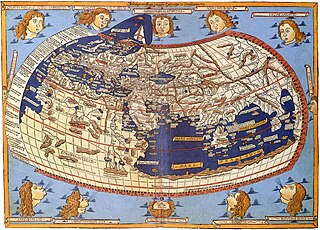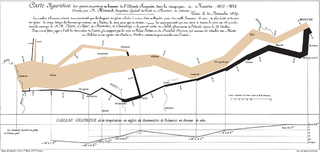
Cartography is the study and practice of making and using maps. Combining science, aesthetics and technique, cartography builds on the premise that reality can be modeled in ways that communicate spatial information effectively.
Media bias occurs when journalists and news producers show bias in how they report and cover news. The term "media bias" implies a pervasive or widespread bias contravening of the standards of journalism, rather than the perspective of an individual journalist or article. The direction and degree of media bias in various countries is widely disputed.

A geographer is a physical scientist, social scientist or humanist whose area of study is geography, the study of Earth's natural environment and human society, including how society and nature interacts. The Greek prefix "geo" means "earth" and the Greek suffix, "graphy", meaning "description", so a geographer is someone who studies the earth. The word "geography" is a Middle French word that is believed to have been first used in 1540.
News values are "criteria that influence the selection and presentation of events as published news." These values help explain what makes something "newsworthy."
The hostile media effect, originally deemed the hostile media phenomenon and sometimes called hostile media perception, is a perceptual theory of mass communication that refers to the tendency for individuals with a strong preexisting opinion on an issue to perceive media coverage as biased against their position's side and in favor of their antagonists' point of view. Partisans from opposite sides of an issue will tend to find the same coverage to be biased against them. The phenomenon was first proposed and experimentally studied in the 1980s by Robert Vallone, Lee Ross and Mark Lepper.

Regional geography is one of the major traditions of geography. It focuses on the interaction of different cultural and natural geofactors in a specific land or landscape, while its counterpart, systematic geography, concentrates on a specific geofactor at the global level.

Waldo Rudolph Tobler was an American-Swiss geographer and cartographer. Tobler is regarded as one of the most influential geographers and cartographers of the late 20th century and early 21st century. He is most well known for coining what has come to be referred to as Tobler's first law of geography. He also coined what has come to be referred to as Tobler's second law of geography.

Health geography is the application of geographical information, perspectives, and methods to the study of health, disease, and health care. Medical geography, a sub-discipline of, or sister field of health geography, focuses on understanding spatial patterns of health and disease in relation to the natural and social environment. Conventionally, there are two primary areas of research within medical geography: the first deals with the spatial distribution and determinants of morbidity and mortality, while the second deals with health planning, help-seeking behavior, and the provision of health services.

Spatial analysis is any of the formal techniques which studies entities using their topological, geometric, or geographic properties. Spatial analysis includes a variety of techniques using different analytic approaches, especially spatial statistics. It may be applied in fields as diverse as astronomy, with its studies of the placement of galaxies in the cosmos, or to chip fabrication engineering, with its use of "place and route" algorithms to build complex wiring structures. In a more restricted sense, spatial analysis is geospatial analysis, the technique applied to structures at the human scale, most notably in the analysis of geographic data. It may also be applied to genomics, as in transcriptomics data.

Gatekeeping is the process through which information is filtered for dissemination, whether for publication, broadcasting, the Internet, or some other mode of communication. The academic theory of gatekeeping may be found in multiple fields of study, including communication studies, journalism, political science, and sociology. Gatekeeping originally focused on the mass media with its few-to-many dynamic. Currently, the gatekeeping theory also addresses face-to-face communication and the many-to-many dynamic inherent on the Internet. Social psychologist Kurt Lewin first instituted Gatekeeping theory in 1943. Gatekeeping occurs at all levels of the media structure—from a reporter deciding which sources are presented in a headline story to editors choosing which stories are printed or covered. Including, but not limited to, media outlet owner and advertisers.

A thematic map is a type of map that portrays the geographic pattern of a particular subject matter (theme) in a geographic area. This usually involves the use of map symbols to visualize selected properties of geographic features that are not naturally visible, such as temperature, language, or population. In this, they contrast with general reference maps, which focus on the location of a diverse set of physical features, such as rivers, roads, and buildings. Alternative names have been suggested for this class, such as special-subject or special-purpose maps, statistical maps, or distribution maps, but these have generally fallen out of common usage. Thematic mapping is closely allied with the field of Geovisualization.
Mark Stephen Monmonier is a Distinguished Professor of Geography and the Environment at the Maxwell School of Citizenship and Public Affairs of Syracuse University. He specializes in geography, geographic information systems, toponymy, and the history of cartography.
In behavioral geography, a mental map is a person's point-of-view perception of their area of interaction. Although this kind of subject matter would seem most likely to be studied by fields in the social sciences, this particular subject is most often studied by modern-day geographers. They study it to determine subjective qualities from the public such as personal preference and practical uses of geography like driving directions.

Political journalism is a broad branch of journalism that includes coverage of all aspects of politics and political science, although the term usually refers specifically to coverage of civil governments and political power.

Geography is the study of the lands, features, inhabitants, and phenomena of Earth. Geography is an all-encompassing discipline that seeks an understanding of Earth and its human and natural complexities—not merely where objects are, but also how they have changed and come to be. While geography is specific to Earth, many concepts can be applied more broadly to other celestial bodies in the field of planetary science. Geography has been called "a bridge between natural science and social science disciplines."
Cartographic propaganda is a map created with the goal of achieving a result similar to traditional propaganda. The map can be outright falsified, or created using subjectivity with the goal of persuasion. The idea that maps are subjective is not new; cartographers refer to maps as a human-subjective product and some view cartography as an "industry, which packages and markets spatial knowledge" or as a communicative device distorted by human subjectivity. However, cartographic propaganda is widely successful because maps are often presented as a miniature model of reality, and it is a rare occurrence that a map is referred to as a distorted model, which sometimes can "lie" and contain items that are completely different from reality. Because the word propaganda has become a pejorative, it has been suggested that mapmaking of this kind should be described as "persuasive cartography", defined as maps intended primarily to influence opinions or beliefs – to send a message – rather than to communicate geographic information.

Technical geography is the branch of geography that involves using, studying, and creating tools to obtain, analyze, interpret, understand, and communicate spatial information.

How to Lie with Maps is a nonfiction book written by Mark Monmonier detailing issues with cartographic representation and targeted at the general public. First published in 1991 by the University of Chicago Press, it explores the various ways in which maps can be manipulated and how these distortions influence the general public's perceptions and understanding of the world. The book highlights the subjectivity involved in map-making and the potential for misuse of cartographic techniques, with a goal to "promote a healthy skepticism about maps."
Technological Transition in Cartography is a seminal book by Mark Monmonier, first published in 1985. The book explores the impact of technological advancements on the evolution of the field of cartography, examining how innovations in technology have transformed the methods and practices of mapmaking. The book was created to target cartography students of the time, and sought to demonstrate the importance of viewing cartography as a method of delivering geographic information, rather than using the technology.
Mark Monmonier is a geographer with a long track record of publications that have been influential to the discipline. In 2023, the American Association of Geographers awarded Monmonier a lifetime achievement award, with prominent mention of his publication track record, specifically stating, "Monmonier’s works are timeless and have transformed how people see, analyze, and interact with maps." Monmonier stands out from other academics in that he published several books aimed at the general population. His most famous book, How to Lie with Maps has been referred to as the "bible for cartographers" by Steven Bernard of the Financial Times and ""the closest thing to a religious text we have in cartography" in Spatial Literacy in Public Health: Faculty-Librarian Teaching Collaborations. His publication Maximum-Difference Barriers : An Alternative Numerical Regiodization Method lead to what is now referred to as the "Monmonier Algorithm."








